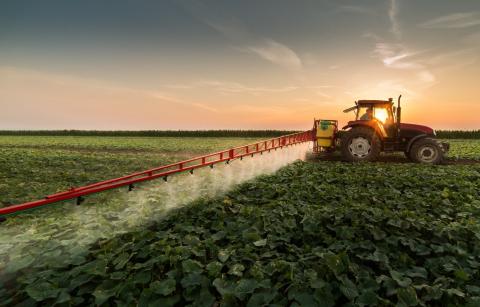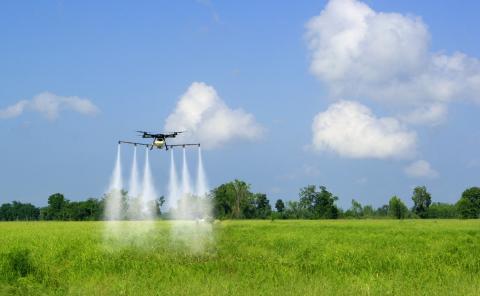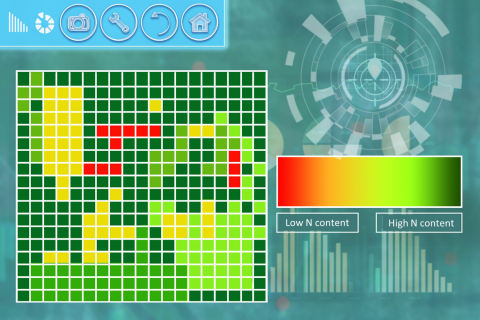5 January 2022
Dr David Cutress: IBERS, Aberystwyth University.
- Feeding plants through their leaves is common for a boost in some nutrients but not for the main limiting nutrient, nitrogen, in crops and pastures
- Crops have shown some good results from foliar feeding nitrogen mainly in reducing nitrogen quantity applied overall, but this involves complex planning and variability
- Whilst currently very little evidence is found for grassland specific foliar N application as a low-input, low environmental impact alternative to soil N, this could well change with continued research in nanoparticle fertilisers
What is foliar feed
A common concern within modern agriculture is our continued and increased reliance on artificial fertilisers, particularly for nitrogen (N) as this is the most limiting plant nutrient. In the last year many fertilisers have undergone over a 100% increase in price making their reduction even more economically relevant. Despite price increases, demand for fertilisers is ever expanding in order to achieve increased yields of crops or pasture for the global food supply chain. Fertiliser production and application accounts for a significant proportion of a traditional crop, livestock or mixed farm’s energy input as well as a significant level of their costs each year. It is recognised that intensive and suboptimal artificial fertiliser application is linked with negative impacts on groundwater nutrient levels and water system leaching which can have knock-on environmental emission and ecosystem effects. Foliar fertiliser application is one alternative method that relates to providing fertiliser nutrients directly to a plant’s leaves compared to most solid or prill fertilisers which are incorporated through the soil via the plant’s roots. The suggestion being that such a fertiliser strategy can be lower input with higher targeting to reduce fertiliser quantities and costs. Application of treatments, nutrients and other substances including water via the method of foliar absorption through spraying is far more common in horticultural than arable systems but it does still occur with some nutrients. Foliar application of nutrients such as boron, calcium, sulphates, iron and other elements where deficiencies can impact health and growth are more common in crops than the direct addition of nitrogen. Importantly foliar nutrient application calculations should include random (spatial and temporal) plant tissue tests compared to the soil tests advised for solid and prill fertilisers calculations. The majority of research surrounding foliar fertiliser use in grasslands specifically was performed over 30 years ago, with largely neutral or negative results.
Production impact
Previous trends from studies in grassland foliar N use mostly demonstrated no significant impacts, more recent studies have also echoed this conclusion when comparing to soil-based applications of N. A study investigating the use of foliar N in subtropical Australian regions found comparable pasture growth rates to traditional solid fertiliser application for short-rotation ryegrass with 40% less N applied per area. However, it was noted that soil available nitrogen fell dramatically in foliar sprayed grass plots which could have long term implications on sustained production. Furthermore, nitrogen use efficiency whilst comparable between solid and liquid fertilisers was marginally higher for solid fertiliser treatments. Whilst applying liquid N fertilisers to leaves may not have as dramatic impacts on improving crop yields as solid fertilisers applied to soil one benefit is it may be a cheaper option when utilising readily soluble products such as urea. Whilst urea may be a cheaper spray alternative due to lower concentrations used, this has caveats to long term spraying due to toxic build ups of biuret present in cheapear urea fertilisers, meaning it functions best on shorter rotation annual systems. Whilst less of an issue for temperate climates like the UK, studies have found that for foliar N to be absorbed most effectively in some climates a wetting agent needs to be included in the application. Furthermore, temperature impacts the dissolvability of nutrient with colder temperatures forcing solutes out of solution quicker, this highlights potential difficulties for the global use of such a fertiliser strategy.
Whilst grassland specific studies give varied results and are less common than studies of crops, several crop-based studies have demonstrated more positive results relating to foliar N application. In a study on the application of foliar fertilisation on pulses at critical crop stages alongside soil fertilisers, it was shown that foliar sprays increase yields over soil fertilisation alone by up to 15 – 25%. Whilst this seems positive it did not calculate nitrogen use efficiency of the dual use of two nitrogen sources so the environmental impact of such a strategy could be high. In recent studies of grain production, it was observed that, within fertile Italian soils, N soil application could be entirely replaced by lower quantities of foliar N spray whilst still maintaining grain yields. It was also predicted that this could reduce nitrogen load on fields between 25 - 40%. Other studies have noted the importance of timing of foliar application of N within the growth cycle of crops and how this can lead to differing plant property impacts (seed number, nutrient content and yield). The foliar application of N in crops requires more complex specific consideration before use, as in some instances it has been shown to have no beneficial impact at all. Furthermore, it is also noted that the application of N and some other nutrients direct to the leaves of crops can cause issues surrounding leaf burn due to phytotoxicity of the nutrients at high levels if incorrectly calculated.
Recent research and alternatives
One study looking at the impact of targeted foliar N fertiliser application in white clover hybrid ryegrass pastures demonstrated beneficial impacts of foliar feed over two growth cycles with regards to application costs and equal or marginally improved dry matter yields compared to conventional options. It was noted that application required careful consideration with regards to weather conditions and plant regrowth phase nutrient requirements. Other research targeting foliar fertiliser use at specific plant growth stages (particularly when supplemented with boron due to its role in pollen tube growth in plants) found that this can have beneficial impacts in improving seed yield for successive meadow grasses. This suggests a potential role in managing self-seeding pasture activities. A study looking at various fertiliser application strategies found a more significant impact (in vegetation pots/plate experimental systems not in field) from the incorporation of controlled-release fertilisers either alone or in combination with foliar fertilisers on the green matter and dry matter production in perennial ryegrass. Currently, an ongoing European Innovation Partnership (EIP) project in Wales, is looking at assessing direct comparisons of foliar feeding strategies against standard N fertilisers and controls across four farms. Evaluations of yields, N remaining in systems, costs and impacts on species diversity are all being collected to understand the impact of such strategies on grassland production. The project has demonstrated to date that whilst yields decrease compared to traditional fertiliser use, the actual amount of N supplied to the system and as such the proportional efficiency of N utilisation is far better with foliar feeding than traditional fertiliser strategies. This might suggest a role in using this technique towards mitigating some environmental impact of grassland management, particularly in certain circumstances.
As nutrient application via foliar methods requires penetration into the leaf, new systems utilising nanoparticles are showing promise for their ability to cross this barrier more easily. Several essential mineral nanoparticles are already being applied via foliar application in crop research and have shown interesting effects, including increasing yields, improving insect pest control, enhancing crop nutrition profiles and reducing oxidative stress in drought conditions. It is noted, however, that little evaluation of nanoparticle related N, P (phosphorous) and K (potassium) application have been performed to date, but research into nanoparticles of these key elements could result in foliar-applied nutrients with sustained-release properties or selective targeting in future. This, if optimised, could have specific roles in the application of nutrients to difficult to reach pastures (such as uplands) via the incorporation of drone-based spraying if legislation in this area was to change in the UK. One very recent study that has looked at N in nanoparticles involved applications for calcium to durum wheat. These nanoparticles were ‘doped’ with urea and it was found that absorption occurred most efficiently through the roots rather than leaves, use lead to reduced nitrogen dosages of 40% having similar yields and quality to their higher N controls. This may suggest nanoparticle research outside of foliar specific applications may have even better prospects moving forwards.
Climate impact
Applying nutrients via a foliar method optimally should involve smaller quantities of N used within schemes, thus reducing the risk of run-off and water pollution as well as overall reductions in energy required to produce the nutrients applied. Whilst this appears to be the case the lack of specific scientific study in this area in grasslands makes it difficult to confirm but may well be something that is of interest for future study if the benefits of foliar feeding become prominent. Foliar application of N has more readily been discussed in orchard situations where this can reduce N available for leaching in the soil. However, for best success in terms of yields, such options often require higher overall N application than traditional methods as they rely on a combination of foliar N spray and soil-applied N. Another concern environmentally is the impact of spray drift when applying any chemicals in this manner, previous studies have noted the ability for sprays to lead to off-target localisation and direct contamination of aquatic environments, increased runoff and even human bystander exposures in some cases.
Summary
Foliar feeding may play some key roles for deficiencies in certain nutrients in crop-based systems and may have improved future roles in combination with nanoparticles research. But, foliar feed is massively understudied in grassland systems. Its impacts and efficiencies in other crop systems could offer some insights useful for transfer. However, an area that has undergone far higher research, as well as direct positive impacts in its commercial application, is the use of targeted precision mapping of pasture nutrients as well as precision application of fertiliser utilising such maps. This achieves essentially the same goals of improving N use efficiency and thus reducing N pollution and is likely why current foliar grassland N application information is so limited. Whilst recent research in Wales may indicate foliar spray benefits in grassland systems with regards to reduced N application and improved efficiency of N utilisation compared to controls it may well be more interesting to compare direct results of foliar N feed vs precision mapped variable rate application technologies (VRT) applying N fertiliser, as this may indicate foliar N application to be less effective. However, even if the foliar N strategy was shown to be less effective than using precision systems it could still have roles in improving environmental management (via reducing N application) in grasslands and crops that are difficult to apply VRT technologies due to access or topography etc, particularly if drone technology was incorporated.
If you would like a PDF version of the article, please contact heledd.george@menterabusnes.co.uk



